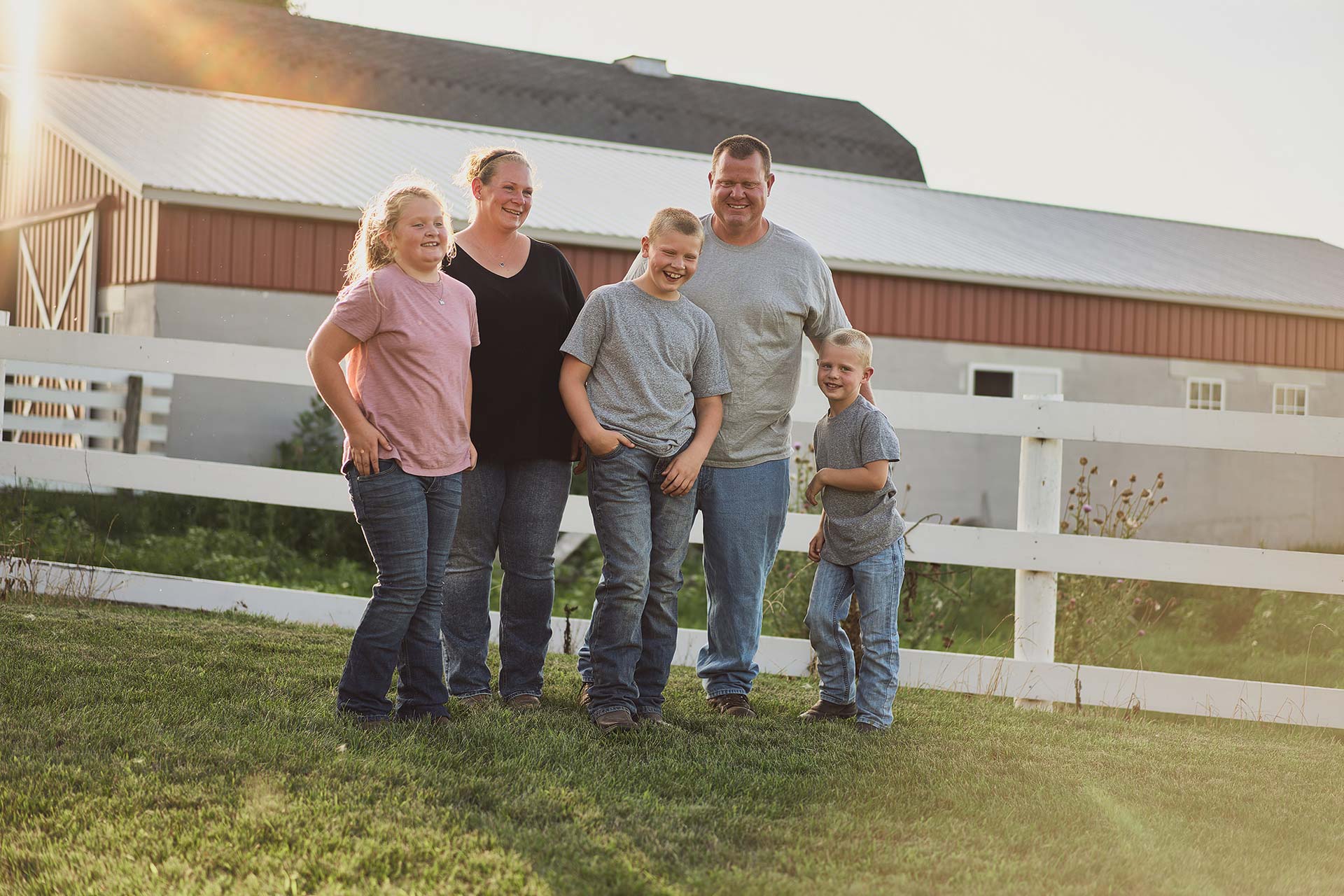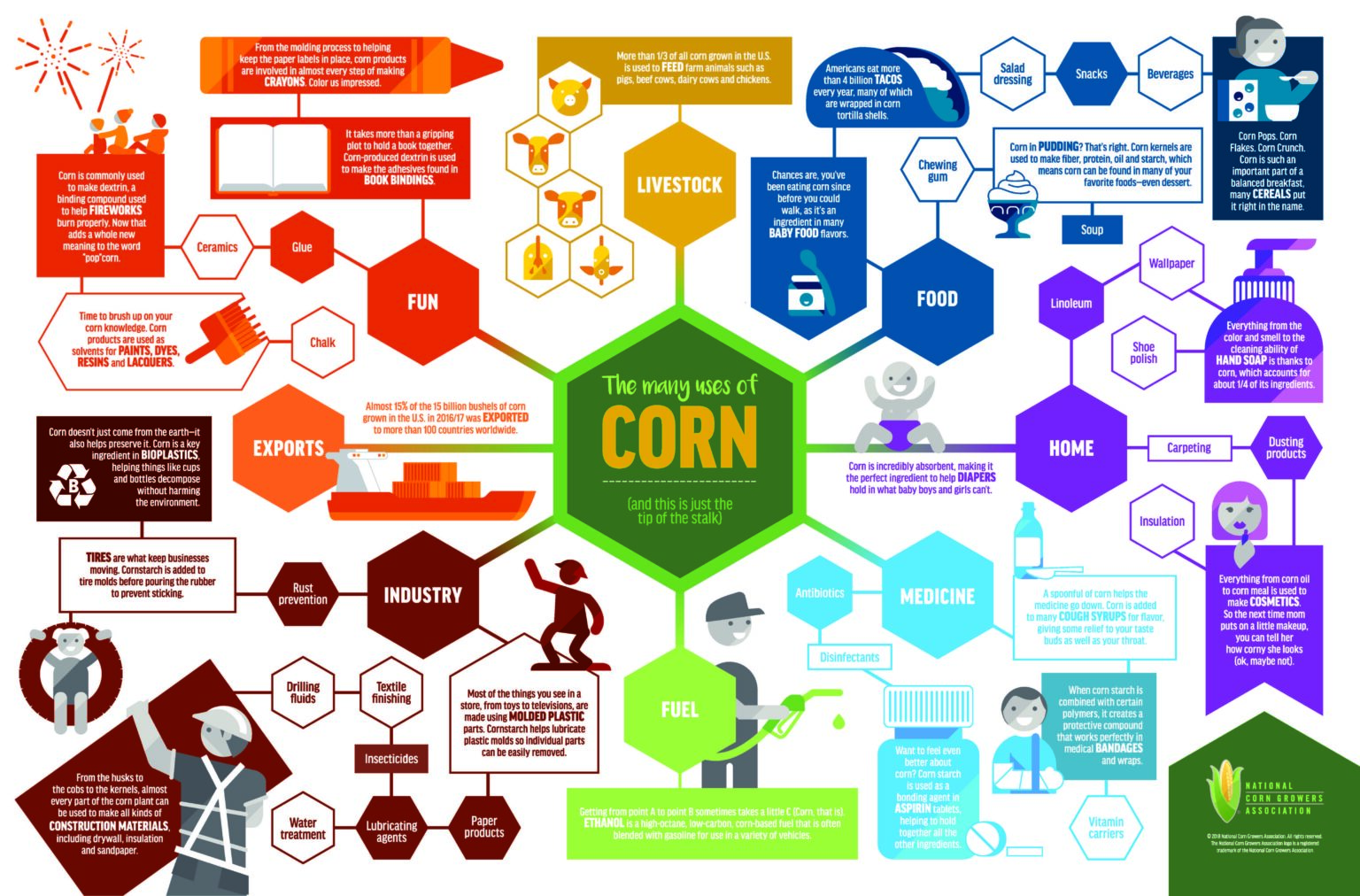Corn Facts
Wisconsin corn at a glance

About 60% of the corn grown in Wisconsin stays on family farms and is used to feed dairy cattle, beef cattle, pigs, chicken and other livestock.


What are the different types of corn?
Corn is corn, right? Not so fast! There are several different types of corn and not all of them are the kind of corn we eat.

Dent Corn
Dent corn gets its name because of the dent, or dimple, that forms on the top of each kernel when it starts drying out. It is commonly called “field corn”.
That’s right, the most commonly grown corn in the United States is grown mostly for non-food purposes. It’s primarily used for fuel, livestock feed and in thousands of other bio-based products like carpet, cosmetics and aspirin. Food uses include corn flour made from ground, dried corn often found in corn tortillas and corn chips.
Dent corn is also used to make ethanol. The by-products of ethanol — distillers’ grains — can provide high-quality food for our livestock.
Dent corn is more commonly grown here than sweet corn, mostly because it’s in higher demand. Only about one percent of the all the corn grown in the United States is sweet corn.
Sweet Corn
Sweet corn is the main kind of corn people eat. This is the type you’ll find in the produce aisle of your grocery store.
If you’ve ever taken a bite out of an ear of field corn you’ll know pretty quickly it’s not the same as sweet corn. Field corn is much higher in starch and doesn’t have as much sugar to make it sweet like the other types. Sweet corn is harvested when the kernels are soft and flavorful. Field corn is harvested later in the season when the plant has dried, the leaves and stalk have turned brown, and the kernels are hard.
Fun Fact: Sweet corn kernels always grow in an even number of rows on the cob.


Popcorn
This is used — you guessed it — as a crunchy snack. Popcorn is similar to field corn. The seed is especially neat because different varieties can grow different colors of kernels.
Flint Corn
Flint corn, which we know as Indian corn, is more common in Central and South America. There, they use flint corn similar to how we use field corn — as feed for livestock. It’s not grown much in the United States, although it can be found in one top agritourism attraction!

Sweet corn vs. field corn fun facts


- Less than 1% of all corn grown across the U.S. is sweet corn!
- Most Wisconsin farmers grow field corn or yellow dented corn that is dried and harvested each fall.
- During the busy harvest season farm families sometimes work around the clock combining corn. Today’s farm machinery includes GPS, WI-FI, and other modern conveniences.
More fun facts about corn
- Corn is grown in every state of the United States.
- Each bushel used for ethanol produces 2.8 gallons of fuel, 18 pounds of dried distillers’ grains (a high protein livestock feed), 14 pounds of corn gluten pellets, 1.8 pounds of corn oil and 17 pounds of carbon dioxide (used in dry ice, the beverage industry, water treatment facilities and other applications).
- Corn can be produced in various colors including blackish, bluish-gray, purple, green, red and white but the most common color grown is yellow.
- There is one silk for every kernel that grows in an ear of corn.
- The number of kernels per ear can vary from 500 to about 1,200, but a typical ear would have 800 kernels in 16 rows.
- Corn is grown in every continent except Antarctica.
- One acre of corn is about the size of a football field.
- A bushel of corn is 56 pounds, about the weight of a large bag of dog food.
- A single corn bushel can sweeten about 400 cans of soda pop.
Surprising Corn Facts and Uses
There are a lot of reasons why — more than 4,000 of them!
That’s right — corn is used for a lot more than food. Corn is mainly used as livestock feed and to produce ethanol. Wisconsin also exports a lot of its corn to other countries. But corn is also a key ingredient in thousands of items we use every day and can be found in everything from crayons to fireworks!
Take the starch, for example. It can be processed into a fine powder which acts as a thickening agent in the kitchen. If you’ve ever savored gravy or other sauces, you probably have cornstarch to thank for the rich, velvety texture.
- Cornstarch can also be found in a lot of other products, including biodegradable cups and plates, rubber tires and coatings for pills and vitamins.
- When fermented, starch from corn can also be used to make ethanol. Only the starch from the kernel is used to make ethanol, leaving the rest of the grain to be used as a high-protein animal feed called distillers grains. It turns out, animals love distillers grains! So, ethanol and animal feed go hand-in-hand. Many ethanol plants also extract oil from the corn, and another coproduct is carbon dioxide with can be used to add fizz to soda pop and to make dry ice.
- Starch can also be used to make dextrin, which is highly adhesive and is used in stamps and envelopes, wallpaper glue and glues in food labels.
- Dextrin is also used in fireworks. It helps bind the explosive elements and makes sure they ignite and burn at the proper speed.
- Corn oil is ideal for frying tortilla chips for some corn-on-corn deliciousness! Corn oil is also used in certain salad dressings, hand soap and hair conditioner. Those fancy products at the spa? They just might include corn oil.
The protein in corn has some pretty cool uses, too. It can be used to make materials that help repair teeth. It’s also a vital component in feed for animals like chicken, cattle and hogs. You might even be using corn closer to home by feeding critters in your aquarium. Yep, corn protein is used in fish food!
Corn can also be used to produce a soluble fiber that’s added to various foods like high-fiber pasta.
Corn can be converted to sugars like high fructose corn syrup to help flavor other foods. Sugars derived from corn can also be used in intravenous drips to improve blood sugar levels, shoe polish and concrete.
Family farmers and homegrown corn

Wisconsin is home to about 15,000 corn farmers, each supporting local towns and communities as well as providing food, fuel, and everyday products for their neighbors.

94% of all farms in Wisconsin remain family-owned and operated. Some farms are larger today to support multiple generations of families working together.

Dane County grew the most corn in 2021 with 1+M tons. Fond du Lac, Manitowoc, Dodge and Brown Counties rounded out the top 5 corn-growing counties in the state.





